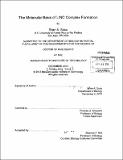The molecular basis of LINC complex formation
Author(s)
Sosa-Alvarado, Brian A. (Brian Alexander)
DownloadFull printable version (12.33Mb)
Alternative title
Molecular basis of linkers of the nucleoskeleton and cytoskeleton complex formation
Other Contributors
Massachusetts Institute of Technology. Department of Biology.
Advisor
Thomas U. Schwartz.
Terms of use
Metadata
Show full item recordAbstract
The nucleus is the hallmark of the eukaryotic cell. It contains most of the genetic material and it separates the processes of replication and transcription from that of translation. Communication between the nucleus and the cytoplasm occurs mostly through openings in the nuclear envelope composed of nuclear pore complexes. These massive assemblies allow for regulated transport of macromolecules across the barrier that is the nuclear envelope. However, another means of communication between the nucleus and the cytoskeleton has been characterized: linkers of the nucleoskeleton and cytoskeleton, or LINC, complexes mechanically connect the nucleus with its surroundings allowing for nuclear anchorage and nuclear movement during development and chromosome movement during meiosis. At the heart of LINC complexes are inner nuclear membrane resident SUN proteins and outer nuclear membrane resident KASH proteins. In this thesis we structurally characterize the human SUN2-KASH1 and KASH2 complexes and provide the molecular basis for their interaction. The solved structures suggest plausible models for high-order of LINC complex assembly as well as LINC complex mediated spacing between the inner and outer nuclear membrane. Questions about how these complexes are regulated also arise from the structure. TorsinA is an AAA+ ATPase suggested to play a role in LINC complex regulation. Analysis of Torsin's binding partners LAP1 and LULL1 show that they are catalytically inactive AAA+ ATPases. We characterize the complex and show by EM that they form ring akin to other AAA+ ATPases. With these studies we provide the first structural analysis of LINC complexes and Torsin ATPases and also provide biochemical tools for the study of LINC complex regulation.
Description
Thesis: Ph. D., Massachusetts Institute of Technology, Department of Biology, February 2014. Cataloged from PDF version of thesis. "December 2013." Includes bibliographical references.
Date issued
2014Department
Massachusetts Institute of Technology. Department of BiologyPublisher
Massachusetts Institute of Technology
Keywords
Biology.